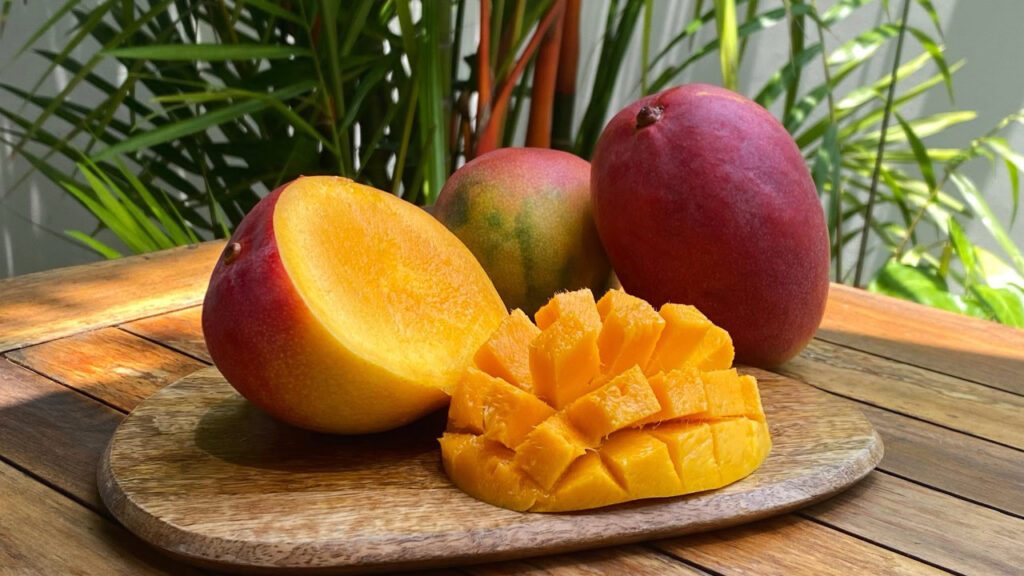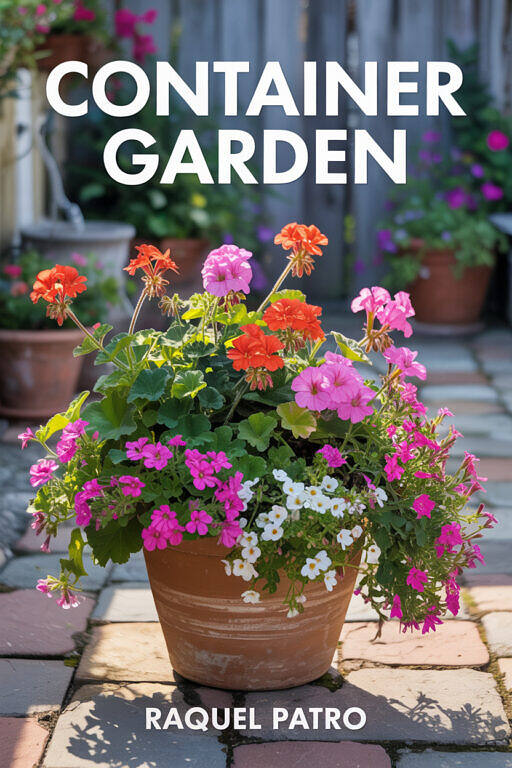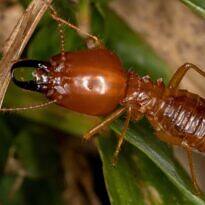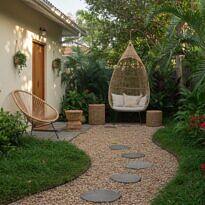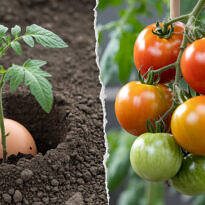Have you ever imagined picking juicy mangoes straight from your backyard?
Growing a mango tree from a seed can be a fascinating and rewarding process. Besides being an economical way to have a fruit tree, this method allows you to follow every stage of the plant’s growth, from germination to fruiting. But can any seed germinate and produce good fruit? How can you ensure that your mango tree grows strong and healthy?

In this article, we’ll teach you how to plant a mango tree from seed in a detailed way, covering everything from selecting the ideal seed to the essential initial care needed for successful growth. If you want to learn an effective and proven method to germinate mango seeds, you’re in the right place!
Before starting, it’s important to understand that while a mango tree grown from seed may take longer to produce fruit than a grafted one, it can be more resilient and better adapted to the local environment. So, if you have available space and the patience to watch this development, keep reading to discover how to efficiently plant a mango tree from seed!

Ideal Climate for Growing Mango Trees
The mango tree (Mangifera indica) is a tropical tree that thrives best in warm and humid climates. Its ideal temperature range is between 75°F and 86°F (24°C to 30°C), though it can tolerate temperatures between 50°F and 104°F (10°C to 40°C) with some restrictions. Regions with harsh winters, frequent frosts, or temperatures below 41°F (5°C) are unsuitable for outdoor mango cultivation, as the plant suffers severe damage and may not survive.
If you live in a temperate climate, growing mango trees in pots inside greenhouses or protected areas can be a viable alternative, especially for dwarf varieties. However, without adequate heat exposure, fruit production may be compromised. Before planting, evaluate your region’s climate conditions and choose more resilient varieties if there are sudden temperature variations.
Choosing the Right Seed
Selecting the right seed is one of the crucial first steps to ensuring the successful growth of your mango tree. Many people make the mistake of planting any seed from a store-bought mango without considering essential factors such as genetic quality and germination viability. To avoid disappointment, follow these recommendations:
What’s the Best Mango to Grow from Seed?

Not all mango varieties are ideal for growing from seeds. Some are hybrids and may not produce fruit with the same characteristics as the original mango. The best options include:
- Palmer Mango (Mangifera indica ‘Palmer’) – A widely cultivated commercial variety with sweet flavor and reddish skin.
- Tommy Atkins Mango (Mangifera indica ‘Tommy Atkins’) – One of the most popular varieties, featuring large fruits and good disease resistance.
- Espada Mango (Mangifera indica ‘Espada’) – Fast-growing, with deep orange pulp and a distinctive flavor.
- Kent Mango (Mangifera indica ‘Kent’) – Low fiber and intense flavor.
If you want to ensure that the tree produces fruits identical to the mother plant, grafting may be a better option. However, if your goal is to experience the natural growth of the tree and obtain a strong, well-adapted plant, selecting a good seed is the first step.
How to Choose a Healthy Fruit for Seed Extraction
The quality of the fruit directly influences germination and the plant’s initial development. Follow these guidelines when selecting a mango:
- Choose a ripe, healthy fruit without dark spots or signs of deterioration.
- Prefer mangoes harvested directly from a tree rather than store-bought ones, as many undergo preservation processes that may affect seed viability.
- Opt for fruits from local trees, as they will be better adapted to your region’s climate and soil.

Properly Extracting the Mango Seed
Most mango seeds do not have a prolonged dormancy period, meaning they can germinate soon after being removed from the fruit. However, some varieties have very thick husks, which can delay germination. To prevent this, it’s essential to use techniques to speed up the process. After choosing the ideal mango, the next step is to extract the seed from the husk (pit). Follow this procedure:
- Cut around the husk – Use a sharp knife to remove the mango pulp without damaging the inner pit.
- Thoroughly clean the pit – Remove all pulp residue by washing it under running water and using a soft brush.
- Let the pit dry – Allow it to dry in a ventilated area, away from direct sunlight, for 24 hours. This helps reduce the risk of fungal infections.
- Carefully open the husk – Using a knife or pruning shears, make a cut along the husk’s side and remove the seed inside. It resembles a large, flat bean.
How to Determine if a Seed is Viable for Planting?

Not all extracted seeds will germinate. Before planting, perform a quick viability test:
- Check the seed’s color – It should be beige or slightly greenish. Dark or shriveled seeds usually won’t germinate.
- Feel the surface – If it’s firm and free of mold, it’s a good sign that it may sprout.
- Float test – Place the seed in a glass of water. If it sinks, it has a good chance of germinating; if it floats, it may not be viable.
When to Plant a Mango Seed?
The ideal time to plant a mango seed directly affects the success of germination. The best period is in spring and summer when temperatures are higher, promoting seedling growth. Avoid planting in winter, as low temperatures can slow down or even prevent germination.
Methods to Speed Up Germination
For those looking to efficiently grow a mango tree from seed, a few methods can help:
- Mechanical Scarification: Lightly sanding the seed surface helps speed up water absorption.
- Water Soaking: Placing the seed in a glass of water for 24 hours can accelerate germination.
- Moist Paper Towel Method: Wrapping the seed in a moist paper towel and placing it inside a plastic bag can stimulate germination before planting in soil.

Germinating the Seed Using the Moist Paper Towel Technique
Before planting the seed directly in soil, an effective method to stimulate germination is using a moist paper towel. This technique is 100% optional, but it creates a controlled environment ideal for the development of the first roots, ensuring that only viable seeds are planted. It follows the same principles as the childhood experiment of sprouting beans in moist cotton.
Step-by-Step Guide
- Preparing the Materials
- Wrapping the Seed
- Place the prepared mango seed (without the hard husk) at the center of the paper towel.
- Fold the paper towel over the seed, covering it completely.
- If preferred, use a sealed plastic bag or a closed container to create a humid environment.
- Storage and Monitoring
- Keep the package in a warm, dark place, such as inside a cabinet or near an indirect heat source (ideal temperature between 72°F and 82°F [22°C to 28°C]).
- Check the moisture level every two days, adding water if needed.
- After 7 to 14 days, the seed will begin to sprout roots and shoots.
- Transferring to Soil
- When the root reaches at least 1.2 inches (3 cm), the seed is ready for planting in soil.
- Carefully plant it with the root facing downward and the shoot pointing upward.
This technique increases the success rate of germination and allows you to monitor the seed’s development before planting it in its final location. Plus, it’s a fun process!

How to Plant a Mango Seed
Now that the seed is prepared, it’s time to understand how to plant a mango seed in soil or a pot to ensure the best plant development.
Choosing the Ideal Location
Mango trees can be grown in pots or directly in the ground. However, they are large trees that can exceed 33 feet (10 meters) in height. Therefore, if the goal is to keep the plant compact, regular pruning will be necessary, or growing in large pots should be considered.
Soil Preparation
The type of soil directly affects plant growth. The ideal soil should be:
- Well-draining to prevent water accumulation.
- Rich in organic matter to provide essential nutrients.
- With a pH between 5.5 and 7.5 to create a balanced environment for growth.
If you are preparing a substrate for planting in pots, a recommended mix for mango seed planting is:
- 40% topsoil
- 30% sand to improve drainage
- 30% organic compost or worm humus

How to Plant a Mango Seed in a Pot
If you want to grow a mango tree in a smaller space, follow these steps to plant it in a pot:
- Choose a pot at least 40 cm (16 inches) deep with drainage holes.
- Fill the pot with the recommended soil mix.
- Make a hole about 2 to 3 cm (0.8 to 1.2 inches) deep and place the seed inside.
- Lay the seed flat and lightly cover it with the substrate.
- Water the soil until it is moist but not waterlogged.
- Keep the pot in a warm, well-lit location, preferably receiving at least 6 hours of sunlight daily.

How to Plant a Mango Seed Directly in the Ground
If your goal is to grow the mango tree in the garden, follow these steps:
- Choose a sunny location – Mango trees need at least 8 hours of sunlight per day.
- Dig a hole about 10 cm (4 inches) deep and prepare the soil as previously mentioned.
- Plant the seed with the thinner side facing downward and cover it with a light layer of soil.
- Water regularly, keeping the soil moist but never waterlogged.
- Protect the seed from animals and pests by using a mesh cover or temporary barrier.
Average Germination Time
The mango seed can take between 2 and 4 weeks to germinate, depending on the variety and environmental conditions. The germination time can be shortened using pre-germination techniques.
Moisture and Temperature Control

Germination occurs more quickly when the soil is kept slightly moist. Here are some tips to ensure optimal moisture levels:
- Water the seed whenever the soil surface starts to dry out.
- Avoid excessive watering to prevent fungal growth and root rot.
- Cover the soil with a thin layer of mulch or sawdust to help retain moisture.
- During germination, avoid excess moisture, as it can lead to seed rot.
How to Know If Germination Was Successful
After a few weeks, a sprout will begin to emerge from the soil. The first signs of successful germination include:
- Small roots emerging from the base of the seed.
- A green shoot breaking through the soil.
- Gradual growth of the first leaves.
Fun Fact: Polyembryonic Seeds – Two Seedlings from One Seed
Did two mango trees sprout from a single seed?

An interesting characteristic of mango seeds is that some varieties have polyembryonic seeds, meaning they produce more than one embryo within the same seed. This means that when you plant a single seed, two or more seedlings may sprout simultaneously. This phenomenon occurs because, in addition to the embryo resulting from fertilization (zygotic), the seed can produce additional embryos that are genetic clones of the mother plant.
This peculiarity is a major advantage for the commercial propagation of mango trees, as the seedlings originating from the additional (clonal) embryos retain the same characteristics as the mother plant, ensuring uniform fruit quality, disease resistance, and standardized growth. This eliminates the need for grafting in some varieties and facilitates large-scale cultivation.
Polyembryonic varieties are widely used in commercial orchards, especially in tropical countries where productivity and uniformity are sought. If you plant a polyembryonic seed, you can choose the most vigorous seedling for cultivation and discard the others, or even try to develop both, maximizing the seed’s potential.
What to Do If the Seed Does Not Germinate?
If the seed does not germinate after a month, check the following factors to identify and correct any issues (then try again with a new seed!):
- Excess or lack of water – The soil should be moist but not waterlogged.
- Inadequate temperature – Mango seeds require warmth to germinate.
- Non-viable seed – Some seeds may not be healthy. Always choose mature and healthy fruits.
Transplanting the Seedling to Its Final Location
After successful germination, the mango tree will begin to grow and will eventually need to be transferred to its final location. Transplanting is an essential step to ensure the tree’s healthy development by providing adequate space for root growth and allowing the plant to establish itself properly.
When to Transplant the Mango Seedling?

Knowing the right time to transplant the seedling is crucial. Ideally, you should wait until the seedling has:
- Grown between 30 cm and 50 cm (12 to 20 inches) tall, with at least 4 to 5 well-developed leaves.
- A strengthened root system, ensuring it can adapt to the soil without excessive stress.
- At least 3 to 6 months of age, as very young seedlings are more fragile and may not survive replanting.
Just like germination, the best time for transplanting is in spring or early summer, when temperatures are higher, and rainfall helps the seedling adapt to its new environment.
Choosing the Ideal Planting Location
The location where the mango tree is planted directly influences its longevity and productivity. Consider the following factors:
- ✅ Sunlight – Mango trees require full sun, needing at least 8 hours of direct sunlight per day to grow strong and produce healthy fruit.
- ✅ Adequate space – A mango tree is large and can reach between 10 and 30 meters (33 to 98 feet) in height, depending on the variety. Ensure a minimum radius of 5 to 7 meters (16 to 23 feet) from other trees and structures. Avoid planting in small gardens where it may become disproportionate.
- ✅ Suitable soil – Prefer sandy or sandy-clay soil that is well-drained, deep, and rich in organic matter. Avoid highly compacted soil, as it hinders root growth.
- ✅ Protection from strong winds – Although mango trees are hardy, excessive wind can break young branches. If possible, plant in an area protected from strong winds.
Step-by-Step Transplanting Guide
- Prepare the soil – Dig a hole 50 cm (20 inches) wide by 50 cm (20 inches) deep and mix the removed soil with organic matter, such as worm humus or compost.
- Add drainage – If the soil is very clayey, add a layer of coarse sand at the bottom of the hole to improve drainage.
- Carefully remove the seedling – If it is in a pot, water it before removal to facilitate taking out the root ball without damaging the roots.
- Plant the seedling in the center of the hole – Position the seedling so that the base of the stem is at soil level.
- Fill the hole with soil – Avoid over-compacting to prevent suffocating the roots.
- Water immediately – The first watering should be generous to eliminate air pockets in the soil and ensure proper moisture.
How to Care for the Mango Tree in the First Few Months
After transplanting, the mango seedling needs special care in the first few months to ensure it grows strong and adapts well to its new location.
Watering Frequency

- During the first few weeks, water 3 to 4 times per week, keeping the soil moist but not waterlogged.
- After the first month, reduce the frequency to 1 to 2 times per week, especially if regular rainfall occurs.
- During dry periods, increase watering to ensure the plant does not suffer from water stress.
Proper Fertilization
For healthy growth, mango trees need essential macro and micronutrients. Follow these fertilization guidelines:
- ✅ Every 30 days during the first 6 months, apply:
- 100 g (3.5 oz) of aged cattle manure or worm humus;
- 50 g (1.8 oz) of bone meal to strengthen the roots;
- 30 g (1 oz) of NPK 10-10-10 to stimulate initial growth.
- ✅ From the 7th month onward, gradually increase the dosage as the tree grows.
- ✅ After 1 year, fertilize every 3 months with NPK 14-14-14 or 20-10-10 (or a specific fertilizer for fruit trees) to maintain growth.
Weed Control
Weeds compete for nutrients and can attract pests. To prevent this issue, regularly weed around the sapling to avoid other plants hindering its growth. Use mulching, such as pine bark or dry leaves, to retain moisture and prevent the spread of unwanted plants. An interesting alternative is planting perennial peanut grass, which covers the soil while also fixing nitrogen for the tree’s absorption.
Protection Against Cold and Frost
If you live in a region where frosts occur, protect your mango sapling:
- Cover the plant with non-woven fabric (NWF) or perforated plastic during cold nights.
- Use cut PET bottles to cover the trunk and prevent the roots from freezing.
Pruning and Training the Mango Tree

Pruning is essential for structuring the mango tree, ensuring balanced growth, and facilitating future harvesting. But when should you start pruning the mango tree?
- The first pruning can be done when the sapling reaches about 3.3 feet (1 meter) in height.
- Maintenance pruning should be carried out annually, always at the end of winter or the beginning of spring.
How to Perform Training Pruning
- Remove low lateral shoots – This prevents the plant’s energy from being wasted.
- Select a strong main trunk – If multiple stems exist, keep only one and remove the others.
- Cut thinner and inner branches – This improves ventilation and reduces the risk of fungal diseases.
- Maintain a balanced shape – Ideally, allow the canopy to develop open and not too tall, facilitating light penetration and harvesting.

Benefits of Pruning for Fruit Production
Besides making the tree more aesthetically pleasing and organized, pruning helps to:
- ✅ Stimulate fruiting – Removing dry and unproductive branches directs energy towards flower and fruit development.
- ✅ Reduce the risk of pests – Less dense foliage improves air circulation and reduces disease hotspots.
- ✅ Facilitate harvesting – Well-pruned trees have accessible branches, making mango picking easier.
Prevention and Control of Diseases and Pests
When learning how to grow a mango tree from seed, it is essential to understand the main phytosanitary challenges that can affect the plant’s development. Diseases and pests can compromise the health of the mango tree and reduce its productivity. Prevention, through good cultivation practices, is the best strategy to ensure a strong and resilient tree.
Common Mango Tree Diseases
The most frequent diseases in mango trees are caused by fungi, bacteria, and viruses. The main ones include:
- Anthracnose (Colletotrichum gloeosporioides) – Causes dark spots and lesions on leaves, flowers, and fruits. Prevention: pruning for aeration and copper-based fungicides such as Bordeaux mixture.
- Powdery mildew (Oidium mangiferae) – Forms a white powder on leaves and flowers, affecting fruit production. Control: application of powdered sulfur and adequate plant spacing.
- Root rot (Phytophthora spp.) – Occurs in waterlogged soils, causing root decay. Solution: efficient drainage and systemic fungicides.
Most of these fungal diseases can be prevented in your orchard by using resistant and adapted varieties and through preventive applications of Bordeaux mixture, a homemade fungicide made from sulfur and lime.

Pests Affecting the Mango Tree
- Fruit fly (Anastrepha spp., Ceratitis capitata) – Pierces fruits and lays eggs inside. Control: traps with natural attractants and fruit bagging.
- Mites and scale insects – Suck the plant’s sap, weakening the leaves. Control: neem oil and natural predators such as ladybugs.
- Caterpillars and borers – Damage leaves and trunks. Management: manual removal and biological control.
Prevention and Control Methods
- Select varieties adapted to your climate and soil.
- Maintain sanitary pruning to remove diseased branches.
- Use balanced fertilization to strengthen the plant.
- Avoid excessive soil moisture.
- Apply natural preventive treatments such as Bordeaux mixture and garlic extract.
With these care measures, your mango tree will grow healthy and strong, ensuring a good fruit yield!
The Growth of a Mango Tree: What to Expect?
Planting a mango tree from seeds is a rewarding process, but it requires patience. Unlike grafted saplings, which can start bearing fruit within a few years, a mango tree grown from scratch may take anywhere from five to eight years to produce its first fruits. During this period, the tree undergoes various growth stages, requiring specific care to ensure healthy and vigorous development.
Growth Stages of a Mango Tree
The life cycle of a mango tree grown from seed can be divided into the following stages:
- Germination and Initial Sprouts (30 to 60 days) – After planting, the seed begins to germinate, producing its first sprouts and roots. Soil moisture and ambient temperature play a crucial role in this stage.
- Vegetative Growth (1 to 3 years) – During this period, the plant develops its trunk and branch structure. Providing balanced fertilization, regular watering, and formative pruning is essential for structuring the tree.
- Structural Maturation (3 to 5 years) – The tree begins to strengthen, with a sturdier trunk and a denser canopy. Depending on care and maintenance, it may start producing its first flowers.
- First Fruiting (5 to 8 years) – The mango tree finally reaches reproductive maturity, and the first fruits begin to appear.

Differences Between Mango Trees Grown from Seeds and Grafted Trees
Many people wonder whether growing a mango tree from seeds is advantageous compared to grafting. Here are some key differences:
- Time to Fruit Production – While a grafted mango tree can bear fruit in 2 to 3 years, a seed-grown tree may take up to 8 years.
- Fruit Characteristics – The fruit of a grafted mango tree retains the same characteristics as the parent plant, whereas a tree grown from seed may produce different fruits, with variations in flavor, size, and texture.
- Longevity and Resistance – Mango trees grown from seeds tend to be more resistant to diseases and pests, as well as having a longer lifespan.
How to Encourage Faster Growth
Although mango tree development is a natural process, certain practices can help accelerate its growth:
- Provide Fertile, Well-Drained Soil – Fertilization with organic matter rich in nitrogen, phosphorus, and potassium promotes vigorous growth.
- Maintain Balanced Irrigation – A lack of water can slow the tree’s growth, while excessive watering may lead to fungal diseases.
- Perform Regular Pruning – Removing weak branches and shaping a well-balanced canopy supports overall plant development.

When Does a Mango Tree Start Producing Fruit?
As mentioned earlier, a mango tree grown from seed can take between 5 to 8 years to bear fruit. The exact timeframe depends on factors such as mango variety, climate conditions, soil fertility, and plant management. Some trees may produce flowers earlier than expected, but these do not always result in fruit.
Learning how to grow a mango tree from seed is a process that requires patience, dedication, and care. Throughout this guide, we have explored all the necessary steps to cultivate a healthy mango tree, from germination to fruiting.

Growing a mango tree from seeds not only provides delicious fruits in the future but also offers an educational and sustainable experience. By following these guidelines, anyone can transform a simple mango pit into a lush and productive tree.
If you are ready to embark on this journey, plant your seed and follow your mango tree’s growth with dedication. The wait will be well worth it when you harvest your own fresh mangoes, grown with care!

